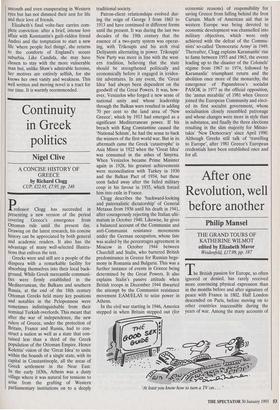After one Revolution, well before another
Philip Mansel
THE GRAND TOURS OF KATHERINE WILMOT edited by Elizabeth Mayor Weidenfeld, £17.99, pp. 187 The British passion for Europe, so often ignored or denied, has rarely received more convincing physical expression than in the months before and after signature of peace with France in 1802. Half London descended on Paris, before moving on to other countries inaccessible during the years of war. Among the many accounts of this interlude of peace and pleasure, few have the sparkle of the diary of an Irish- woman called Katherine Wilmot. Original- ly published in 1920 under the absurd title An Irish Peer on the Continent (she was accompanying the Earl and Countess of Mount Cashel), The Grand Tours of Kather- ine Wilmot is a new selection by Elizabeth Mayor.
Would any unknown young woman today enjoy the access which Katherine Wilmot took for granted in 1802? In that European age, the educated elite spoke French so fluently, and obtained introductions so easily, that within a month of her party's arrival on 5 December 1801
with our eyes flying out of our sockets at everything we beheld,
they had met the legendary political survivor, the Abbe Sieyes and were frequenting David's house. Katherine Wilmot's keen visual sense is shown in her description of the great painter:
His mouth is dreadfully distorted and turn'd almost into one cheek, so that his jaw teeth are discoverable to the front. I can't describe to you the carnivorous aspect this produces.
Another evening she was handed in to dinner by none other than Talleyrand:
At a distance, his face is large, pale and flat like a cream cheese but on approaching near- er, cunning and rank hypocrisy supplant all other resemblances.
He had
such a smile as 1 never desire to see, as long as I live, again.
Well educated, broad-minded and inquisi- tive, Katherine Wilmot was a natural diarist, interested in manners and customs, and determined to amuse her brother Robert to whom she sent her journal once a week. Moreover, she was in Paris at the crucial moment when the First Consul was introducing the forms of monarchy, before the official proclamation of the Empire.
The fine words Liberte, Egalite and Fra- temite were inscribed on public buildings, but Katherine Wilmot was not deceived: 'Tis nonsense to talk of the French being Republicans; I don't think a spark exists among them. They are excessively fond of rank, honours and every etiquette that can distinguish them from the multitude . . However, there is a great independence among the lower ranks of people that I hear is one of the blessings of the Revolution.
At dinner at the Tuileries Josephine Bona- parte sat under a canopy 'blazing in purple and diamonds'. Although Katherine Wilmot was disarmed by Bonaparte — 'so charming a smile as his, I never scarcely beheld' — she saw that he was already sur- rounded by a court.
After a year in France, Katherine Wilmot and the Mount Cashels moved on to Italy, visiting Turin, Florence and Naples. She noted that, at the opera in Naples, instead of watching the perfor- mance on stage, spectators were so busy inside their boxes that they 'scarcely both- ered to undraw their curtains'. Of King Ferdinand IV she wrote:
His face surpasses any abridgement of imbecility I ever saw in all my life.
The second half of the book describes Katherine Wilmot's visit to Russia in 1805-7. Her sister Martha was living there as protegee of one of those independent women characteristic of the 18th century, Princess Dashkov. Having helped Cather- ine II seize the throne in 1762, 40 years later, at Troitskoe outside Moscow, the Princess was mistress of 3,000 serfs,
all her subjects and loving her as if she was their mother.
She acted as her own doctor, surgeon and lawyer and corrected the priest in church 'if he is not devout'. The Princess and her friends talked so much of the late Empress that Katherine Wilmot wrote: I confess I am heartily sick of the name of Great Catherine by this group of displaced dotards. She is praised uniformly with refer- ence to their own services.
Indeed, the Wilmots grew to hate, and be hated by, most 'Bears' as they called the Russians. Martha Wilmot had been given so much money by her besotted hostess (£5,000?, £18,000?) that the Princess' daughter grew jealous. In 1807 Katherine, and a year later her sister, decided to leave; the diary ends.
Elizabeth Mayor, who has also edited the journals of William Beckford and Fanny Kemble, is a connoisseur of old travel diaries. She makes interesting comparisons between Katherine Wilmot's diary and those of other visitors to Paris, the more conservative and censorious Maria Edge- worth and Fanny Burney. However, her editing could have been more informative. Katherine Wilmot, who died, unmarried, in Paris in 1824, at the age of 51, remains a shadowy figure. Who were General and Madame de Soubiran, who gave a 'brilliant ball composed of all the nations of the earth' in Paris? Katherine Wilmot has clearly misspelled a name, for they are unknown to biographical dictionaries (`Lucasina' is Katherine Wilmot's spelling of the Prussian ambassador, the Marchese Lucchesini). Although Elizabeth Mayor has added some unpublished material, it does not replace what has been cut; the book contains only 176 pages, a third of what Katherine Wilmot wrote. Nevertheless, her journal is so vivid that The Grand Tours of Katherine Wilmot opens a hole in the wall of time, enabling the reader to recapture the texture and spirit of life in the early 19th century.











































































 Previous page
Previous page